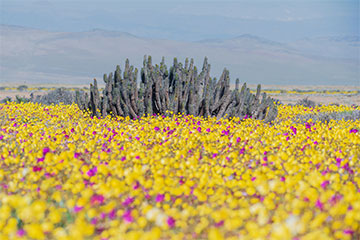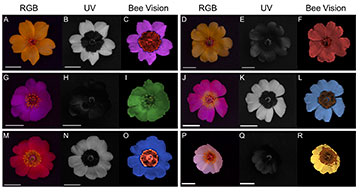
Taken during the 2021 “desierto florido” near Caldera, Chile. The purple flowers are Cistanthe longiscapa, the subject of the current study. [Image: O. Pérez-Nates]
In Chile’s Atacama Desert, a generous amount of rainfall in winter brings about an extraordinary flowering event in spring known as “desierto florido,” or “blooming desert.” Despite being one of the driest places on Earth, the landscape becomes awash in vibrantly colored blossoms, as water reaches seeds and bulbs that have lay dormant in the ground.
Recently, researchers in Chile, the Netherlands and New Zealand teamed up to investigate the mechanisms of floral color diversity in a particular species that dominates these superblooms (Front. Ecol. Evol., doi: 10.3389/fevo.2022.957318). Using various optical techniques, they discovered that the petals of Cistanthe longiscapa can be highly variable in terms of the colors and patterns they present to insect pollinators.
Imaging the blooming desert
In October 2021, a massive blooming of C. longiscapa occurred near the city of Caldera, Chile, covering the desert floor with a blanket of purple and yellow flowers. Jaime Martínez-Harms and his colleagues decided to take the unique opportunity to study the plant in detail, collecting specimens in the field and keeping them fresh until experimentation. They noticed that, between the masses of purple and yellow flowers, the same species had sprouted in red, pink and white as well.
“We have a general interest in understanding the processes that promote biological diversification in an extreme environment such as the Atacama Desert and, in particular, about how the interactions with pollinators may shape the diversity of flower forms observed in the blooming desert,” said Martínez-Harms, a researcher at the Institute of Agricultural Research in La Cruz, Chile.
They employed a digital camera modified for increased UV sensitivity to take both RGB and UV images of the flowers. The photos revealed that, while their coloring appears uniform to humans, reflectance in the UV range of the spectrum forms a distinct bullseye pattern. To characterize the differences between the distal and proximal petal areas, the researchers performed spectrophotometry on petal pieces using an integrating sphere and deuterium-halogen lamp.
Color varieties of Cistanthe longiscapa flowers shown in RGB and UV photographs, and images represented as they would be seen through the eyes of honeybees. [Image: O. Pérez-Nates] [Enlarge image]
When analyzing the absorption in three wavelength ranges (UV, blue and orange-red), Martínez-Harms and his colleagues found differences in each of the color variations. For example, the yellow flowers contain a pigment with peak absorption at 465 nm, but it also has a UV-absorbing pigment in the proximal area only. The red flowers, on the other hand, have an additional pigment with peak absorption at 570 nm.
Through the eyes of a honeybee
Lastly, the study looked at the flowers from the perspective of a pollinator—specifically, the honeybee. The researchers modeled a perceptual space using the spectral sensitivity of honeybees, which possess three types of photoreceptors, each sensitive to UV-, blue- and green-wavelength ranges. The results demonstrate that insect pollinators are able to perceive greater color diversity in this single plant species than humans.
“We found that flowers of Cistanthe longiscapa are highly variable in the color and patterns they present to pollinators,” said Martínez-Harms. “This variability results from different content of betalain pigments [with different absorption spectra] in the flower petals.”
He believes that the study points to C. longiscapa as a useful species to study betalains, a class of pigment known to be effective as photoprotectants that confer tolerance to drought and salinity stress.
“Despite being of special interest for food and cosmetic industry, betalains have been studied only in a few plant species,” Martínez-Harms said. “The outstanding diversity of betalains found in [this] single plant species could help deepen our understanding about the biosynthesis of different types of betalains.”

